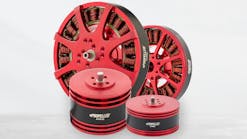Artemis Aerospace Explores the History of the ‘Black Box’
From its invention and throughout its evolution, the "black box" has been crucial for maintaining and improving commercial aircraft safety since the 1950s. Here, component supply specialists Artemis Aerospace explores this essential piece of equipment and how it has developed into the modern technology used by the industry today,
Why is it Called a Black Box?
Although commonly referred to as a "black box," the device's official name is flight data recorder (FDR) or cockpit voice recorder (CVR).
Originally, flight recorders consisted of magnetic tape encased in a fireproof box that was painted black to protect the metal and prevent rust, hence the terminology "black box" – an expression that was made popular by the British during World War II.
However, after FDRs were mandated by the aviation industry in the 1960s, regulations stipulated that all flight recorders must be painted in "international orange" – making them highly visible and easy to distinguish in the event of an incident.
Early Flight Recorders
Although the Australian scientist David Warren is credited with inventing the first flight and voice recorders for the commercial aviation industry, the earliest known design was made by François Hussenot and Paul Beaudoin at the Marignane flight test center in France in 1939.
The "Hussenograph" was a photograph-based flight recorder that used scrolling photographic film and recorded instrument data, such as altitude and speed. Hussenot's and Beaudouin's legacy lives on through the Société Française des Instruments de Mesure, which they founded in 1947 and today forms part of the multi-national manufacturer of aircraft engines and equipment, Safran group.
During WWII, Len Harrison and Vic Husband developed a crash and fire-proof flight recorder for the Ministry of Aircraft Production, setting the standard for today's modern units.
The First Flight Recorders for Commercial Aircraft
Up until the 1950s, flight recorders were primarily used on military aircraft. However, in 1953, Warren's prototype FDR "The ARL Flight Memory Unit" was specifically designed for post-crash investigations of civilian aircraft and was the first to record voices in the cockpit as well as instrument readings.
During the same year, Professor James J. Ryan, who was a professor of mechanical engineering at the University of Minnesota, invented and patented the flight recorder in the United States. However, unlike Warren's invention, Ryan's didn't include a cockpit voice recorder, which wasn't patented in the U.S. until 1961 by Edmund A.Commer Boniface Jr.
As recordings became digitized, this led to the FDR and CVR being combined into one unit called the CVDR.
Most commercial jets are now additionally equipped with a QAR (quick access recorder), meaning data can be easily removed and accessed quickly in the event of less serious incidents, such as unplanned deviations, that require further investigation.
Today's systems are digitally controlled and include built-in test equipment that records how the aircraft is operating. This means that potential issues can be identified and dealt with before an incident occurs, making air travel even safer and more efficient than ever before.
Flight Recorders Become Mandatory
Following the crash of Trans Australia Airlines Flight 538 in 1960, Australia became the first country in the world to make cockpit voice recorders mandatory.
In 1964, the United States passed its first cockpit voice recorder rules requiring all turbine and piston aircraft with four or more engines to install CVRs by March 1967.
By 1967, FDRs had become mandatory in many countries. Commercial aircraft were required to carry FDRs and CVRs housed in bright orange boxes in the tail of the aircraft, where they would stand the best chance of survival in the event of a crash.
FDRs are now governed by ICAO (International Civil Aviation Authority) and the FAA (Federal Aviation Authority) in the United States. These regulators stipulate the specifications and standards FDRs must meet for aircraft. This includes FDRs being equipped with an underwater locator beacon that is automatically activated when an incident occurs.
FDR Improvements and Updates
Despite the introduction of the underwater locator beacon to aid FDR recovery following a crash, the technology was not without its limitations.
Notably, the disappearance of Malaysia Airlines Flight 370 in March 2014, demonstrated the restrictions of flight recorder technology, which required physical possession of the device in order to understand the cause of an accident.
Unable to locate Flight 370 or its FDR, authorities called for live streaming of data from the aircraft to the ground. In addition to this, they requested for the range and battery life on all underwater locator beacons to be extended and that aircraft be fitted with a secondary deployable recorder that would be ejected from the aircraft before impact.
FDRs of the Future
Artificial intelligence and telematics are leading the way in developing the aircraft of the future, including improving the collection of in-flight data and voice recordings.
Honeywell's latest flight deck, Anthem, provides anytime, anywhere data analytics and an engine-out function to automatically guide pilots to the nearest airport, while assessing factors such as terrain and wind speed.
The NTSB (National Transport Safety Board) in the U.S. has long been lobbying for installing cockpit video recorders in new and in-service commercial jets to improve the quality of information that can be gathered following an incident. However, this hasn't been without controversy and ALPA (Air Line Pilots Association) has expressed concerns regarding privacy.
Whatever the future holds for flight data recorders, they will continue to be essential to maintaining safe air travel for all.
Sources
https://www.britannica.com/technology/flight-recorder
https://en.wikipedia.org/wiki/Fran%C3%A7ois_Hussenot
https://en.wikipedia.org/wiki/Flight_recorder
https://www.nytimes.com/2014/04/06/magazine/who-made-that-black-box.html
https://en.wikipedia.org/wiki/Malaysia_Airlines_Flight_370
https://www.flightglobal.com/safety/ntsb-again-calls-for-cockpit-video-recorders/143210.article






